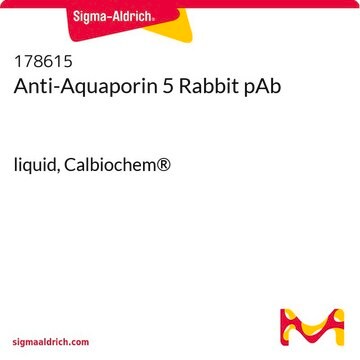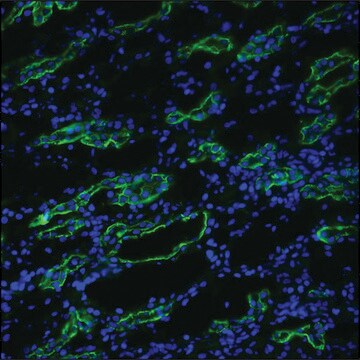詳細
We are committed to bringing you greener alternative products, which adhere to one or more of The 12 Principles of Green Chemistry.This antibody is Preservative-free, produced without the harm or sacrifice of animals and exceptionally stable to allow for ambient shipping and storage if needed and thus aligns with "Waste Prevention", "Designing Safer Chemicals" and "Design for Energy Efficiency".
Click here for more information.
ZooMAb® antibodies represent an entirely new generation of recombinant monoclonal antibodies.Each ZooMAb® antibody is manufactured using our proprietary recombinant expression system, purified to homogeneity, and precisely dispensed to produce robust and highly reproducible lot-to-lot consistency. Only top-performing clones are released for use by researchers. Each antibody is validated for high specificity and affinity across multiple applications, including its most commonly used application. ZooMAb® antibodies are reliably available and ready to ship when you need them.
特異性
Clone 3H17 is a Rabbit recombinant monoclonal antibody that specifically detects Aquaporin-5 in multiple species. It targets an epitope within 25 amino acids from the C-terminal, cytoplasmic domain.
免疫原
KLH-conjugated linear peptide corresponding to 25 amino acids from the C-terminal, cytoplasmic domain of human Aquaporin 5.
アプリケーション
Quality Control Testing
Evaluated by Western Blotting in Jurkat cell lysate.
Western Blotting Analysis: A 1:1,000 dilution of this antibody detected Aquaporin 5 in Jurkat cell lysate.
Tested Applications
Western Blotting Analysis: A 1:1,000 dilution from a representative lot detected Aquaporin 5 in lysates from MCF-7 and Raw264.7 cells and Mouse salivary gland tissue.
Immunocytochemistry Analysis: A 1:100 dilution from a representative lot detected Aquaporin 5 (AQP5) in MCF-7 cell line.
Immunohistochemistry (Paraffin) Analysis: A 1:1,000 dilution from a representative lot detected Aquaporin 5 (AQP5) in human salivary gland tissue sections.
Immunofluorescence Analysis: A 1:1,000 dilution from a representative lot detected Aquaporin 5 (AQP5) in human salivary gland tissue sections.
Affinity Binding Assay: A representative lot of this antibody bound Aquaporin 5 with a KD of 1.7 x 10-7 in an affinity binding assay.
Note: Actual optimal working dilutions must be determined by end user as specimens, and experimental conditions may vary with the end user
ターゲットの説明
Aquaporin-5 (UniProt: P55064; also known as AQP-5) is encoded by the AQP5 gene (Gene ID: 362) in human. Aquaporins, a highly conserved group of membrane proteins that are involved in the bidirectional transfer of osmotically driven water and small solutes across cell membranes. They contain two tandem repeats each containing three membrane-spanning domains and a pore-forming loop with the signature motif Asn-Pro-Ala (NPA). Aquaporin-5 is a homotetrameric, multi-pass membrane glycoprotein that contains six cytoplasmic domains, six continuous transmembrane domains, two discontinuous transmembrane domains, and four extracellular domains. Its amino and carboxyl termini located in the cytoplasm. It is detected in skin eccrine sweat glands, digestive tract, renal cortex, and vaginal epithelial cells. In the respiratory system it is expressed in airways at the apical membrane of columnar epithelial cells and at the apical membrane of serous acinar cells of sub-mucosal glands. In lungs its expression at the apical membrane of type I pneumocytes. It plays an important role in fluid secretion in salivary glands and is shown to be essential for transient receptor potential cation channel subfamily V member 4) (TRPV4) activation by hypotonicity. Together with TRPV4 it controls regulatory volume decrease in salivary epithelial cells. Mutations in AQP5 gene have been linked to the development of palmoplantar keratoderma, a disease that is characterized by an abnormal thickening of the skin on the palms of the hands and soles of feet. Overexpression of Aquaporin-5 has also been observed in several human cancers and knockdown of AQP5 leads to partially reduced cell cycle progression from G1 to S phase and apoptosis. This ZooMAb® recombinant monoclonal antibody, generated by our propriety technology, offers significantly enhanced specificity, affinity, reproducibility, and stability over conventional monoclonals. (Ref.: Direito, I., et al. (2016). Cell. Mol. Life Sci. 73(8); 1623-1640).
物理的形状
Purified recombinant rabbit monoclonal antibody IgG, lyophilized in PBS, 5% Trehalose, normal appearance a coarse or translucent resin. The PBS/trehalose components in the ZooMAb formulation can have the appearance of a semi-solid (bead like gel) after lyophilization. This is a normal phenomenon. Please follow the recommended reconstitution procedure in the data sheet to dissolve the semi-solid, bead-like, gel-appearing material. The resulting antibody solution is completely stable and functional as proven by full functional testing. Contains no biocide or preservatives, such as azide, or any animal by-products. Larger pack sizes provided as multiples of 25 μL.
再構成
300 μg/mL after reconstitution at 25 μL per vial. Please refer to guidance on suggested starting dilutions and/or titers per application and sample type.
保管および安定性
Recommend storage of lyophilized product at 2-8°C; Before reconstitution, micro-centrifuge vials briefly to spin down material to bottom of the vial; Reconstitute each vial by adding 25 μL of filtered lab grade water or PBS; Reconstituted antibodies can be stored at 2-8°C, or -20°C for long term storage. Avoid repeated freeze-thaws.
法的情報
ZooMAb is a registered trademark of Merck KGaA, Darmstadt, Germany
免責事項
Unless otherwise stated in our catalog or other company documentation accompanying the product(s), our products are intended for research use only and are not to be used for any other purpose, which includes but is not limited to, unauthorized commercial uses, in vitro diagnostic uses, ex vivo or in vivo therapeutic uses or any type of consumption or application to humans or animals.








